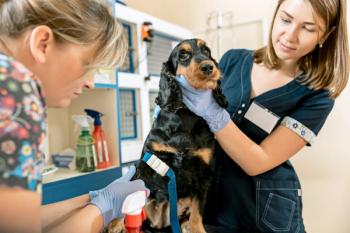
Salary predictions for food animal, government veterinarians
A final look by AVMA economists at factors that correlate with veterinary compensation.
Dr. Ross KnippenbergThe American Veterinary Medical Association (AVMA) conducts a number of surveys each year. The AVMA's Senior Survey is one of our best sources of information. From it we can evaluate the health of the market for new veterinarians and estimate what's likely to happen in the near future. Unfortunately, there's no correspondingly great resource to describe the market for current veterinarians, but the AVMA Biennial Economic Survey comes close. As the name suggests, the Biennial Economic Survey is conducted every two years and collects data on veterinarians' incomes and benefits. The survey provides insight into salary trends and the factors correlated with veterinary income.
Ideally, estimating the differences over time and across each of the horizontally related markets for veterinarians requires only two inputs. The first is gross domestic product (GDP), a common and broad measure of overall economic activity. GDP growth occurs as the result of three factors: inflation, population and productivity. The effect of a growing population is removed by dividing GDP by the size of the population, resulting in what's known as GDP per capita. GDP per capita generally grows over time and is perhaps the most intensely watched of all economic indicators. When GDP per capita is used to help explain variation in veterinary compensation, it serves as a proxy for inflation, productivity and other time-related factors. Our analysis here uses a measure of U.S. GDP per capita provided by the Congressional Budget Office.
The second predictor of compensation is the number of veterinarians in a particular employment category-for example, companion-animal-predominant veterinarians or veterinarians who work in industry. The number of veterinarians should be a good predictor of compensation, because in any market system, demand and supply curves can be completely characterized by price and quantity. In the veterinary market, price is the mean salary and quantity is the number of veterinarians. One of our first steps is to estimate the number of veterinarians in each employment sector, because, unlike with the AVMA's Senior Survey, the number of veterinarians in each employment category is not precisely known.
The AVMA has been keeping track of the number of veterinarians with declared specialties since 2001. To estimate as far back as 1999, when the Biennial Economic Survey series began, we had to estimate quantity based on the AVMA's database of all veterinarians in the United States. To do this, we made several necessary assumptions. The first assumption is that each veterinarian has a maximum career span of 45 years. The second assumption takes into account that 23 percent of individual veterinarians have never communicated their employment classification to the AVMA. We assume that these individuals are proportionally distributed across the profession in known categories.
However, sometimes even the most carefully laid out and executed plans don't amount to much. In our regression coefficient analysis, we came up with only two categories where we could make salary predictions with any degree of statistical confidence: food-animal-exclusive veterinarians and veterinarians who work in state and local government. All other categories did not meet the requirements for statistical significance and feasibility. Future studies will seek to correct this.
To forecast the growth in salaries for food animal veterinarians, we estimated per-capita GDP and the number of food animal veterinarians in the future from linear time trends drawn from 1999 to 2014. These estimates were then multiplied by the coefficients from our regression analysis study.
The number of food-animal-exclusive veterinarians is expected to grow by about 400 over the next 10 years, and mean salaries are expected to rise to about $120,000 (see Table 1). A 1 percent increase in the number of food-animal-exclusive veterinarians would be the addition of almost 16 individuals. This is predicted to decrease compensation by $1620.17, or 1.9 percent of the mean compensation in 2013. Thus the elasticity is 0.01/0.19 = 0.53, indicating that the market for food-animal-exclusive veterinarians is price-inelastic-or relatively insensitive to changes in price.
The number of state and local government veterinarians is predicted to increase by 100 through 2025, and mean compensation will increase to about $106,000 (Table 2). A 1 percent increase in the number of state and local government veterinarians would be the addition of 13.5 individuals. This is predicted to decrease compensation by $2,581.55, or 3.0 percent of the mean compensation in 2013. Thus the elasticity is 0.01/0.030 = 0.33, indicating that the market for state and local government veterinarians is also price-inelastic.
Going forward, the AVMA will convert the Biennial Economic Survey into an annual survey and change the name to the “Compensation Survey.” If you receive an email request to complete one of these or any other AVMA survey, please help the profession by filling it out completely. Furthermore, if you think you are listed in AVMA database as an “unknown” practice type, again please help out the profession by telling the AVMA about your current employment type.
Dr. Ross Knippenberg is an economic analyst for the American Veterinary Medical Association's Veterinary Economics Division. Dr. Mike Dicks is director of the Veterinary Economics Division.
Newsletter
From exam room tips to practice management insights, get trusted veterinary news delivered straight to your inbox—subscribe to dvm360.






